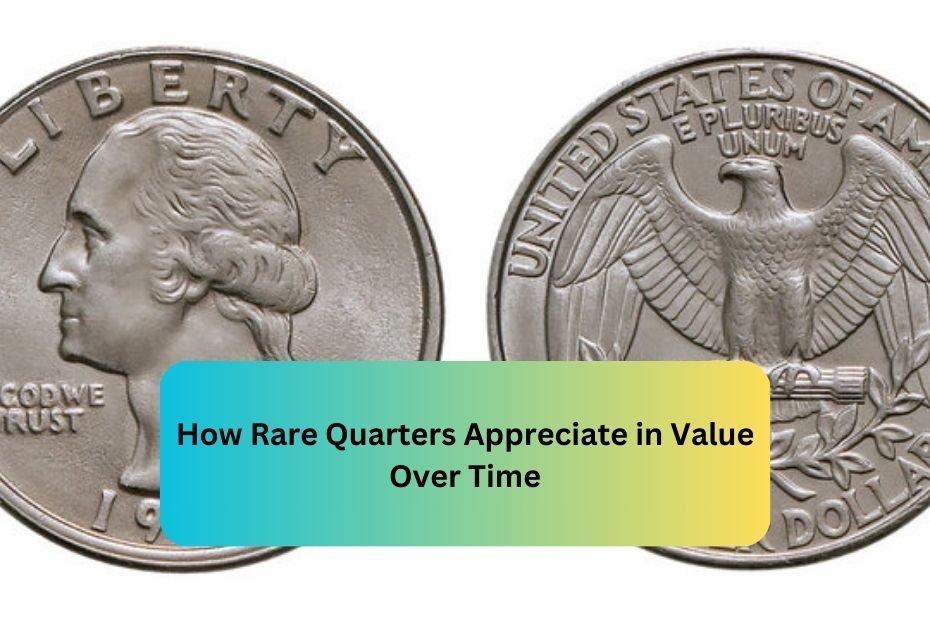Rare quarters are an exciting area of coin collecting, and their value can increase significantly over time. While most people use quarters for everyday transactions, collectors look for specific characteristics that make some quarters highly sought after and valuable. Understanding why rare quarters appreciate in value and what factors contribute to this appreciation can help both new and experienced collectors make informed decisions.
What Makes a Quarter “Rare”?
The rarity of a quarter is determined by several factors, including its age, condition, mint mark, and any errors or unique features that may set it apart from standard coins. Here are some of the most common characteristics that make quarters rare and valuable:
1. Limited Mintage
Coins that were minted in smaller quantities are generally more valuable than those produced in large numbers. A lower mintage means fewer quarters are available, creating scarcity, which can drive up demand and value over time.
2. Historical Significance
Quarters that mark significant events, commemorate historical figures, or represent important periods in history tend to be highly prized by collectors. For instance, the Bicentennial quarter from 1976 is popular because it commemorates the 200th anniversary of American independence.
3. Mint Errors
Mint errors, such as double strikes, off-center coins, or other irregularities, can make a quarter extremely valuable. These errors are rare and occur during the minting process, making the coin unique. Examples of valuable error coins include the 1932-D Washington quarter and the 1955 “double die” quarter.
4. Condition (Grade)
The condition or “grade” of a quarter significantly affects its value. Coins in “mint state” (MS) or uncirculated condition are worth more than those that are worn from use. Coins are graded on a scale from 1 to 70, with higher numbers indicating better condition.
5. Metal Composition
Some older quarters, particularly those minted before 1965, contain 90% silver. These “silver quarters” have intrinsic value due to their metal content, which can increase in value as the price of silver rises.
Why Do Rare Quarters Appreciate in Value?
The appreciation of rare quarters is primarily driven by supply and demand. However, several key factors contribute to how and why these coins increase in value over time:
1. Scarcity
The rarity of a quarter increases its value. As time goes on, fewer rare quarters remain in circulation or mint condition, making them harder to find. This scarcity increases demand, especially among collectors, and leads to higher prices.
2. Condition Preservation
Collectors highly value coins that have been well-preserved. Coins that are kept in excellent condition (such as uncirculated quarters) are more likely to appreciate in value over time. A rare quarter in mint state is much more valuable than one that is heavily worn or damaged.
3. Rising Popularity of Coin Collecting
As more people become interested in coin collecting, the demand for rare quarters grows. This increase in interest can lead to higher prices for certain coins. Additionally, new technologies and resources, such as online marketplaces and auction platforms, make it easier for collectors to buy and sell rare quarters, further driving demand.
4. Metal Value Fluctuations
For older quarters made of silver, the value can appreciate based on the fluctuating price of precious metals. If the price of silver increases, the value of silver quarters can rise accordingly. This means that even if a quarter is not particularly rare, its metal content can make it a valuable investment.
5. Market Trends
Coin collecting markets can experience trends where specific types of coins or particular errors become more popular, driving up their value. For example, a certain error might become more sought after due to publicity or increasing awareness in the collector community, causing a surge in its value.
Notable Rare Quarters That Have Appreciated in Value
Certain quarters have become famous for their rarity and the dramatic increases in their value over time. Here are some notable examples:
1. 1916 Standing Liberty Quarter
The 1916 Standing Liberty quarter is one of the most sought-after U.S. quarters. Only 52,000 were minted, making it extremely rare. In top condition, this coin can sell for over $25,000.
2. 1932-D Washington Quarter
The 1932-D Washington quarter is another highly valuable coin. With only 436,800 minted, it is one of the rarest Washington quarters in existence. Depending on its condition, it can be worth thousands of dollars.
3. 1955 “Double Die” Quarter
The 1955 “double die” quarter is famous for its noticeable minting error, where the design is struck twice, resulting in a blurry or doubled image. This error makes it highly collectible, with values reaching into the thousands.
4. 1976 Bicentennial Quarter
While not as rare as some other quarters, the 1976 Bicentennial quarter is still a popular collector’s item. Quarters in uncirculated condition, especially those with proof finishes, can be worth significantly more than their face value.
5. 2004-D Wisconsin Quarter (Extra Leaf Error)
This modern error coin features an extra leaf on the corn stalk depicted on the back of the 2004-D Wisconsin quarter. Depending on the type of extra leaf, these error coins can be worth several hundred to over a thousand dollars.
How to Start Investing in Rare Quarters
If you’re interested in collecting rare quarters and watching their value appreciate, here are a few tips to get started:
1. Educate Yourself
Before investing in rare quarters, it’s important to do your research. Learn about different mint marks, coin grades, and the history of various quarters. There are many resources available, including books, online forums, and coin collecting apps.
2. Work with Reputable Dealers
When purchasing rare quarters, it’s important to buy from reputable dealers who can authenticate the coins. Many coin dealers are members of professional organizations like the American Numismatic Association (ANA), which ensures that they adhere to high ethical standards.
3. Consider Coin Grading
Having your quarters graded by a professional grading service, such as the Professional Coin Grading Service (PCGS) or the Numismatic Guaranty Corporation (NGC), can help establish their value. A graded coin is more likely to appreciate in value and be easier to sell in the future.
4. Proper Storage
Protect your investment by storing your rare quarters properly. Use coin holders, albums, or cases to prevent damage. Keep the coins in a cool, dry place, away from direct sunlight, to prevent tarnishing.
5. Keep an Eye on the Market
Coin values can fluctuate based on trends, market demand, and the price of precious metals. Staying informed about the latest developments in the coin collecting world will help you make smarter investment decisions.
Conclusion
Rare quarters are more than just pieces of currency; they are valuable collectibles that can appreciate over time. Factors like scarcity, condition, historical significance, and market demand all contribute to the increasing value of these coins. By learning the basics of coin collecting, working with reputable dealers, and keeping a close eye on the market, collectors can watch their rare quarters grow in value, making them a rewarding long-term investment.
FAQs
1. What is the rarest U.S. quarter?
The 1916 Standing Liberty quarter is one of the rarest U.S. quarters, with only 52,000 minted.
2. How do I know if my quarter is valuable?
Factors like mint marks, condition, and any minting errors can make a quarter valuable. Having it appraised or graded by a professional service is a good way to assess its value.
3. Do all silver quarters have value?
Yes, quarters minted before 1965 contain 90% silver and have intrinsic value due to their metal content, which can increase with the price of silver.
4. What is a “double die” error on a quarter?
A “double die” error occurs when the design is struck twice, resulting in a doubled or blurry image. These coins are rare and valuable.
5. How can I protect my rare quarters from damage?
Store your rare quarters in coin holders, albums, or cases, and keep them in a cool, dry place away from direct sunlight to prevent tarnishing.

